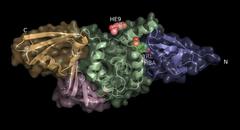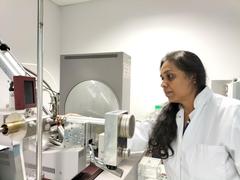URL: https://www.desy.de/news/news_search/index_eng.html
Breadcrumb Navigation
DESY News: Natural substances show promise against coronavirus
News
News from the DESY research centre
Natural substances show promise against coronavirus
Three natural compounds present in foods like green tea, olive oil and red wine are promising candidates for the development of drugs against the coronavirus. In a comprehensive screening of a large library of natural substances at DESY's X-ray source PETRA III the compounds bound to a central enzyme vital for the replication of the coronavirus. All three compounds are already used as active substances in existing drugs, as the team headed by Christian Betzel from the University of Hamburg and Alke Meents from DESY reports in the journal Communications Biology. However, if and when a corona drug can be developed on the basis of these compounds remains to be investigated.

Artistic representation of the coronavirus. Credit: Science Communication Lab for DESY
The papain-like protease (PLpro) is a vital enzyme for virus replication: When a cell is hijacked by the coronavirus, it is forced to produce building blocks for new virus particles. These proteins are manufactured as a long string. PLpro then acts like a molecular pair of scissors, cutting the proteins from the string. If this process is blocked, the proteins cannot assemble new virus particles.

Methyldihydroxybenzoate (HE9) was isolated from the French marigold Tagetes patula. Credit: Pixabay, Sonja Kalee Linkhttps://pixabay.com/de/photos/tagetes-patula-linnaeus-tagetes-4567000/
For the experiments, PLpro was mixed with each of the 500 natural substances in a solution, giving them the chance to bind to the enzyme. It is not possible to see if a substance binds to the enzyme with a conventional light microscope. Instead, tiny crystals were grown from the mixtures. When illuminated with the bright X-rays from PETRA III at the experimental station P11, the crystals produced a characteristic diffraction pattern from which the structure of the enzyme can be reconstructed down to the level of individual atoms. “From this information we can produce 3-dimensional models of the enzyme with atomic resolution and see if and where a substance binds to it,” explains Meents.

Structure of the coronavirus enzyme papain-like protease showing the binding sites of the natural compounds. Credit: University of Hamburg, Vasundara Srinivasan
In subsequent lab tests, established and performed by Hévila Brognaro in Betzel's group, the three phenols reduced PLpro's activity by 50 to 70 per cent in living cells. “The advantage of these substances is their proven safety,” says Betzel, who is also a member of the cluster of excellence CUI: Advanced Imaging of Matter. “These compounds naturally occur in many foods. However, drinking green tea will not cure your corona infection! Like it will not heal your wounds or cure your cancer. If and how a corona drug can be developed from these phenols is subject to further studies.”

The paper's main author Vasundara Srinivasan at an X-ray set-up to test protein crystals in the lab. Credit: University of Hamburg, Susanna Gevorgyan
In the new study, scientists from the University of Hamburg, the University of Sao Paulo in Brazil, Diamond Light Source in the United Kingdom, European XFEL, Bahauddin Zakariya University in Pakistan, Hospital Israelita Albert Einstein in Brazil, Scientific Platform Pasteur in Brazil, the European Molecular Biology Laboratory in Hamburg, Fraunhofer Institute for Translational Medicine and Pharmacology in Hamburg, Jozef Stefan Institute in Slovenia, Centre of Excellence for Integrated Approaches in Chemistry and Biology of Proteins in Slovenia, the University of Greifswald and DESY contributed to the work.
A comprehensive animation that DESY produced together with the award-winning Science Communication Lab illustrates the principles of this research in detail using the example of the coronavirus' main protease Mpro:
Reference:
Antiviral activity of natural phenolic compounds in complex at an allosteric site of SARS-CoV-2 papain-like protease; Vasundara Srinivasan et al.; Communications Biology, 2022; DOI: 10.1038/s42003-022-03737-7



